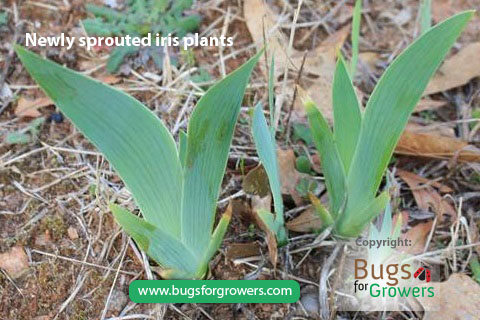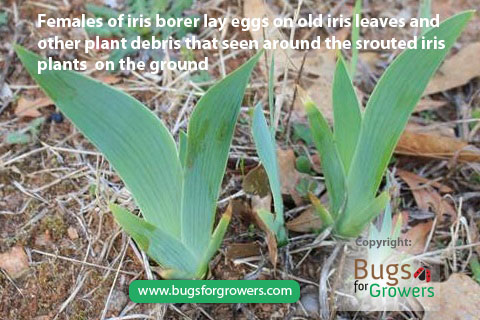Iris plants (Fig. 1) are botanically known as Iris germanica. Until now there are more than 300 species have been described from genus Iris. Irises generally flower in early summer and are known to produce multicolored including blue, orange, pink, purple, white and yellow flowers. These beautiful plants are drought tolerant and deer resistant but very susceptible to iris borers.

What are iris borers?
Iris borers are scientifically called as Macronoctua onusta and considered as one of the most damaging pests of irises. Iris borers develop through four life stages including eggs, larvae, pupae and adults (moths) but only larval stage can cause damage to iris plants. Female moths lay over 100 eggs in a cluster on the old iris leaves/ plant debris in late August and early September (Fig. 2). Eggs survive severe winters in the plant debris and hatch into small larvae early in the spring. These larvae then move into newly sprouted iris foliage and bore into young iris leaves. While feeding inside the leaves, larvae tunnel through leaf tissue and move downwards to the rhizome. Once inside the rhizome, larvae feed internally on rhizome tissue and become mature. Matured larvae then exit damaged rhizomes and move into the soil for pupation. Adult moths emerge from pupae in the fall. After mating, females lay eggs as overwintering stage. These eggs can survive severe winter and hatch in the next spring. Thus the life cycle of iris borers continues and they complete one generation in a year. Injured iris rhizomes are generally susceptible to infection by opportunistic bacterial pathogens like Erwinia carotovora that can cause a disease called bacterial soft rot. Diseased rhizomes generally become soft, slimy and can give foul-smell and eventually they can die.

Biological control of iris borers with beneficial entomopathogenic nematodes?
Killing of young larvae of iris bores before entering into the iris leaves and rhizomes is essential to stop further damage caused by them to iris plants. Similarly, mature larvae of iris borers that exited from damaged rhizomes and moved in the soil for pupation should be killed to stop their future generations. Beneficial entomopathogenic nematodes are thread-like insect parasitic worms that are known to parasitize and kill many soil-dwelling larval and pupal stages of many insect pests including irish borers. Two beneficial nematodes including Heterorhabditis bacteriophora and Steinernema carpocapsae are proved to be effective in killing both young and mature larvae, and pupae of iris borers (Gill and Raupp, 1997).
How beneficial entomopathogenic nematodes can kill iris borer larvae?
Since both young and mature iris borer larvae that are freely travelling on the surface of soil for searching of iris young leaves to enter into them and in the soil for pupation, respectively, they can be easily targeted with beneficial entomopathogenic nematodes. Immediately after application to the soil surface in the iris beds, infective juveniles of Heterorhabditis bacteriophora or Steinernema carpocapsae will start searching for the larvae and pupae of iris borers. Once larvae and/or pupae are located, the beneficial nematode infective juveniles will penetrate into the larval or pupal body cavity via natural openings such as mouth, anus and spiracles. Once in the body cavity, infective juveniles will release symbiotic bacteria, Photorhabdus luminescens associated with Heterorhabditis bacteriophora and Xenorhabdus nematophila associated with Steinernema carpocapsae from their gut in insect blood where multiplying nematode-bacterium complex can cause septicemia and kill larvae and/or pupae of iris borers usually within 24-48 hours after infection.
When is the best time to apply Heterorhabditis bacteriophora or Steinernema carpocapsae nematodes to kill iris borers?
April is the right month to apply Heterorhabditis bacteriophora or Steinernema carpocapsae nematodes to target iris borers because during this time their larvae are already hatched from the overwintering eggs and freely moving on the soil surface to locate and enter into newly sprouted young leaves of irises (Fig. 1) and therefore, these migrating larvae can be easy targets for the nematodes. Both Heterorhabditis bacteriophora and Steinernema carpocapsae nematodes are very active and will be effective in finding and killing of young larvae of iris bores and prevent their entry into the leaves.
To prevent future generations of iris borers, it is also recommended to apply beneficial Heterorhabditis bacteriophora or Steinernema carpocapsae nematodes in the fall (late August to early September) to target fully grown larvae that generally emerge from damaged rhizomes and move into the soil for pupation. This fall application of nematodes can also kill pupae and help to stop the emergence of next generation of moths.
For the effective control of both young and mature larvae, and pupae apply 2300 infective juveniles of Heterorhabditis bacteriophora or Steinernema carpocapsaeper square foot area using water cans. Both nematode species will be equally effective against iris borers if temperature is above 69oF (20oC).
.
Research papers
Gill, S. A. and M. J. Raupp 1997. Evaluation of biological and chemical applications for control of iris borer. J. Environ. Hort. 15:108-110.
